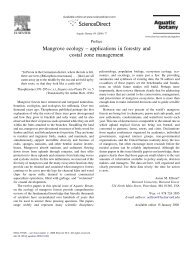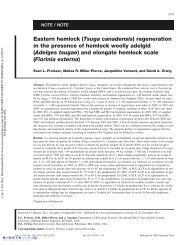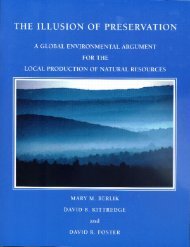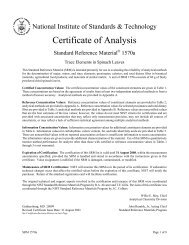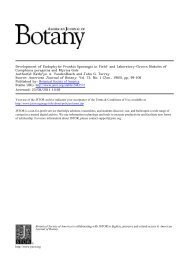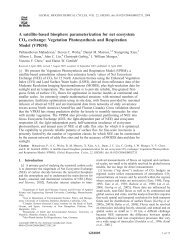Abstracts of Papers - Harvard Forest - Harvard University
Abstracts of Papers - Harvard Forest - Harvard University
Abstracts of Papers - Harvard Forest - Harvard University
Create successful ePaper yourself
Turn your PDF publications into a flip-book with our unique Google optimized e-Paper software.
GLIME, JANICE M. Department <strong>of</strong> Biological Sciences,<br />
Michigan Technological <strong>University</strong>, Houghton, MI<br />
49931. - A photographic study <strong>of</strong> spore and<br />
protonema development in Fontinalis squamosa.<br />
Electron microscopy was used to demonstrate<br />
development and arrangement <strong>of</strong> spores within the<br />
capsule. Spore viability, germination, and protonema<br />
development are illustrated by light and fluorescence<br />
microscopy. The presence <strong>of</strong> two spore sizes is<br />
clearly demonstrated and the reduced viability <strong>of</strong> the<br />
smaller spores is demonstrated by reduced fluoresence.<br />
Germination is demonstrated in culture from 5?C-22?C<br />
and requires light and moisture, but not submersion.<br />
Protonemata branches arise from 1-3 points on the<br />
spore, depending upon conditions. Germination and<br />
development are slow and depend upon the state <strong>of</strong><br />
maturation <strong>of</strong> the spores at the time <strong>of</strong> culture.<br />
Bud development is very slow and the requirements for<br />
budding are unclear.<br />
GOWIAN, SHARON P. Botany Division, National Museum<br />
<strong>of</strong> Natural Sciences, National Museums <strong>of</strong> Canada,<br />
Ottawa, Ontario KIA OM8, Canada - A study <strong>of</strong> ro<strong>of</strong>-<br />
dwelling lichens and the possible effects <strong>of</strong> a<br />
nearby phosphorus plant.<br />
Concern has been expressed by the inhabitants <strong>of</strong> Long<br />
Harbour, Newfoundland, about abundance in their town<br />
<strong>of</strong> ro<strong>of</strong>-dwelling lichens, and the possible relation-<br />
ship <strong>of</strong> their growth to phosphate- and fluoride-con-<br />
taining substances escaping from a nearby phosphorus<br />
plant. In response to this concern, an ecological<br />
study was undertaken to compare the ro<strong>of</strong>-dwelling<br />
lichen community in Long Harbour with that in nearby<br />
towns lacking any significant sources <strong>of</strong> atmospheric<br />
contamination. Results show a concentration <strong>of</strong><br />
"enrichment species", especially Xanthoria polycarpa<br />
and Physcia tenella in Long Harbour, whereas species<br />
characteristic <strong>of</strong> acid bark and rocks, especially<br />
Hypogymnia physodes and H. tubulosa predominate in a<br />
nearby town. Coverages and effect <strong>of</strong> lichens on<br />
their substrate in the two towns are comparable. It<br />
is hypothesized that the abundance <strong>of</strong> enrichment<br />
species in Long Harbour is at least partially a re-<br />
sponse to high concentrations <strong>of</strong> air-borne dust rich<br />
in phosphates.<br />
GRAHAM, LINDA E. Department <strong>of</strong> Botany, Univer-<br />
sity <strong>of</strong> Wisconsin, Madison, WI 53706.<br />
- Coleochaete: Advanced green alga or primitive<br />
embryophyte?<br />
Ultrastructural studies <strong>of</strong> reproductive development<br />
in Coleochaete have revealed a number <strong>of</strong> features<br />
that do not occur elsewhere in the green algae, but<br />
which are characteristic <strong>of</strong> embryophytes. Filament-<br />
ous species <strong>of</strong> Coleochaete produce unicellular<br />
antheridia as do other green algae, but the<br />
parenchymatous species may produce internal, multi-<br />
cellular antheridia that resemble early developmental<br />
stages <strong>of</strong> land plant gametangia. Following<br />
fertilization, the zygote <strong>of</strong> Coleochaete is retained<br />
on the haploid plant, and apparently induces the<br />
formation <strong>of</strong> a layer <strong>of</strong> covering cells that may<br />
produce localized wall ingrowths. These cells<br />
resemble gametophytic placental transfer cells <strong>of</strong><br />
embryophytes in location, time <strong>of</strong> development, and<br />
ultrastructure. Upon germination, the zygote<br />
develops into a multichambered, spore-producing<br />
structure that is not observed elsewhere among<br />
green algae, but which resembles spore mother cells<br />
<strong>of</strong> embryophytes in some important features.<br />
Finally, Coleochaete produces more spores per<br />
Bryological and Lichenological Section 5<br />
fertilization elSent than other freshwater, or<br />
haploid, haplobiontic green algae. This last<br />
feature is probably related to retention <strong>of</strong> the<br />
zygote, zygote enlargement and storage <strong>of</strong> photo-<br />
synthate, and putative nutrient interactions between<br />
haploid aind diploid phases <strong>of</strong> the life cycle. These<br />
features may thus have been preadaptations <strong>of</strong> major<br />
importance during the transition <strong>of</strong> plants to land<br />
and the origin <strong>of</strong> embryophytes from charophycean<br />
algae.<br />
HOARE, JANET K. Room 429 Hensill Hall,<br />
San Francisco State Univ.,San Francisco,CA94132<br />
- Lichen succession<br />
ian lava flows.<br />
and diversity on dated Hawai-<br />
Lichens were collected on lavas <strong>of</strong> thirty-two ages<br />
on the island <strong>of</strong> Hawaii to determine lichen succession<br />
and diversity on a series <strong>of</strong> lava substrates <strong>of</strong><br />
known ages. One hundred eighty-six collections 'were<br />
made at sixty sites representing nine geographic<br />
locations. Stereocaulon is the most prevalent genus<br />
and, with Lepraxia, becomes established in less than<br />
ten years, fo'llowed by foliose genera (largely Parmelias),<br />
and Cladonias. Crustose genera appear on<br />
lavas at least thirty years old, but are uncommon<br />
on lavas younger than a few hundred years. The greatest<br />
lichen diversity was found on old lavas at sea<br />
level in the south-east portion <strong>of</strong> the island where<br />
rainfall is moderate. The most pr<strong>of</strong>use growth (Stereocaulon)<br />
appears on lavas one hundred and fifty<br />
years old in the central saddle area where rainfall<br />
is heavy.<br />
LAWREY, JAMES D. Department <strong>of</strong> Biology, George<br />
Mason <strong>University</strong>, Fairfax, VA 22030.<br />
- Lichen herbivore<br />
ance?<br />
behavior: preference or avoid-<br />
Field data collected in a saxicolous lichen community<br />
in Shenandoah National Park showed that the lichen<br />
herbivore Pallifera varia prefers certain lichen<br />
species to others. Two hypotheses were developed to<br />
explain this preference. The avoidance hypothesis,<br />
that preference by slugs actually results from the<br />
rejection <strong>of</strong> unpalatable species, was tested by <strong>of</strong>fering<br />
slugs choices <strong>of</strong> filter paper disks impregnated<br />
with secondary products <strong>of</strong> the avoided and preferred<br />
species. The preference hypothesis, that slugs select<br />
lichens <strong>of</strong> highest quality, was tested by measuring<br />
the ooncentration <strong>of</strong> essential elements in<br />
lichens eliciting high and low preference by slugs.<br />
Lichens with the highest element contents were assumed<br />
to be <strong>of</strong> highest quality to herbivores. Results<br />
showed that the preferred lichens had significantly<br />
lower concentrations <strong>of</strong> N, P, and Ca, and that<br />
avoided lichens produced secondary compounds that inhibited<br />
P. varia grazing activity. These results<br />
suggested that lichens with high concentrations <strong>of</strong><br />
essential elements are most likely to produce defense<br />
compounds, an observation supporting some explanations<br />
for chemical defense patterns in vascular plants.<br />
Mankiewicz, Paul S. Harding Laboratory,<br />
New York Botanical Garden, Bronx, New<br />
York, 10458<br />
-Water conduction by external capillary<br />
spaces and the shape <strong>of</strong> bryophyte<br />
colonies.<br />
While the major kinds <strong>of</strong> bryophyte colonies<br />
have been well described in the literature,<br />
there have been no empirical studies <strong>of</strong> the<br />
spatial arrangement <strong>of</strong> plant axes in cushions,





